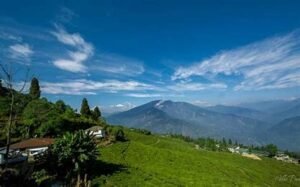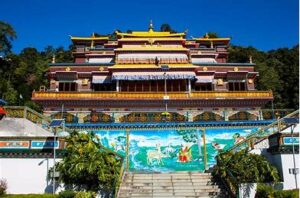Moatsu Mong is a traditional festival celebrated by the Ao tribe of Nagaland. It marks the end of the sowing season. The festival is held in early May, after weeks of hard agricultural work. It is a time of rest, renewal, and bonding for the Ao community. People come together to sing, dance, share food, and give thanks. Moatsu Mong is a symbol of unity and joy, deeply rooted in the tribe’s cultural values.
Historical Roots: A Celebration of Hard Work
Moatsu Mong is an ancient festival. It has been passed down for generations. The Ao tribe is traditionally an agricultural community. After the seeds are sown and the fields are prepared, the villagers celebrate the completion of their labor. The festival began as a way to relax and thank the spirits for protecting the crops.
In the past, it also marked the time for spiritual cleansing and community bonding. It was believed that peaceful celebration would bring good fortune and a successful harvest.
Language and Communication: Passing Culture Through Words
The Ao people speak the Ao language. It has several dialects spoken in different villages. During Moatsu Mong, traditional songs and stories are shared in this language. These songs are not only entertaining but also carry deep cultural meanings.
Elders tell stories from the past. Young people listen and learn. Proverbs, blessings, and chants are passed down orally. This helps to preserve the tribe’s history and wisdom.
Festivals and Celebrations: Three Days of Joy
Moatsu Mong lasts for three days. Each day is filled with activities and rituals. The festival begins with village cleaning. Homes are decorated with flowers and leaves. Community members wear their best traditional attire.
Highlights of the celebration include:
- Singing of folk songs
- Traditional dances
- Feasts and rice beer
- Friendly competitions like wrestling and tug-of-war
The villagers celebrate with joy and unity. The whole community takes part, young and old alike.
Arts, Crafts, and Music: Expressions of Identity
Moatsu Mong showcases the artistic talents of the Ao people. Bamboo and wood crafts are displayed. Baskets, ornaments, and tools are all handmade using traditional methods. These crafts are used in daily life and during the festival.
Music plays a major role. Folk songs are sung in groups. Instruments like log drums and bamboo flutes are played. The music celebrates nature, love, bravery, and community. Songs and dances are practiced before the festival begins.
Cuisine and Culinary Traditions: Food that Unites
Food is an important part of Moatsu Mong. Villagers prepare special meals to share with family and guests. Dishes are made using ingredients like pork, rice, bamboo shoots, and vegetables.
Smoked pork is a favorite. It is slow-cooked and flavored with herbs. Fermented soybeans, local greens, and chili add rich taste. Homemade rice beer, called zutho, is served during meals and rituals.
Food is cooked in bamboo or over firewood. Everyone eats together. Sharing meals shows respect and strengthens community ties.
Attire and Ornamentation: Traditional and Meaningful
During the festival, people wear traditional clothes. Men wear shawls with red, white, and black designs. The patterns show status, bravery, and village identity. Women wear colorful skirts and tops. They decorate themselves with beads, shells, and ornaments.
Feathers, animal horns, and handmade jewelry are common. Every item has meaning. The clothes reflect the person’s age, role, or achievements.
Beliefs and Values: Honoring the Sacred
Moatsu Mong is more than just fun. It carries deep beliefs. The Ao tribe believes in living in harmony with nature and community. The festival honors:
- The spirits of ancestors
- The gods of harvest
- The importance of peace and unity
It is a time to forgive, cleanse the spirit, and begin anew. People pray for good health, strong crops, and family well-being.
Customs and Etiquette: Showing Respect Through Actions
Many customs are followed during Moatsu Mong. Before the festival, people settle disputes. Debts are cleared. Old quarrels are resolved. Cleanliness is important—both personal and in the home.
Elders are respected. Guests are treated with care. Young people serve food and drink to elders. Laughing, singing, and playing games are encouraged, but all behavior must remain respectful.
Architecture and Symbols: Spaces that Speak Culture
Ao villages are made of wooden homes. Houses are built on stilts to protect from rain. The homes are decorated with leaves, symbols, and tools during Moatsu Mong.
The morung, or youth dormitory, is central to the village. It is where boys learn about their culture, songs, and duties. During the festival, the morung becomes a place of music and gatherings. It represents knowledge, unity, and pride.
Oral Traditions and Storytelling: Keeping the Past Alive
Storytelling is a major tradition during Moatsu Mong. Elders gather the youth and tell stories from memory. These stories speak of ancestors, farming, nature, and morality. Some stories are myths, others are true historical events.
There are no written records. Knowledge is passed from one generation to another through the spoken word. This keeps the tribe’s identity alive.
Interactions with Nature: A Life of Balance
The Ao people live close to nature. Their farming is done with care. Moatsu Mong celebrates the bond between people and the land. Rituals use natural items like water, leaves, wood, and grain.
The festival takes place after sowing. It is a time to rest and respect the earth. Farming tools are cleaned. Prayers are made for rainfall and good crops.
Nature is not just used—it is honored. The Ao people believe that humans and nature must live in balance.
Challenges and Preservation: Holding on to Tradition
In today’s world, change is fast. Many young Ao people move to cities. Western clothes, food, and music influence everyday life. Some old customs risk being forgotten.
But many steps are being taken to protect this culture:
- Schools teach traditional songs and language
- Community events promote Ao heritage
- Moatsu Mong is celebrated with pride
- Elders are encouraged to share stories
Digital tools are also used to record language, music, and rituals. These efforts help preserve the festival for future generations.
Cultural Contributions: Sharing Knowledge and Art
The Ao tribe has shared many cultural gifts with the region and beyond:
- Art and Weaving: Their handwoven clothes and bamboo crafts are admired widely.
- Philosophy: The Ao way of life teaches harmony, discipline, and gratitude.
- Agriculture: Their farming methods are sustainable and eco-friendly.
- Oral Tradition: Their stories and songs are rich with meaning and wisdom.
These contributions add to the cultural richness of India and inspire others to value tradition and balance.
Connection to Northeast India: A Part of the Whole
Moatsu Mong is a vital part of the culture of Northeast India. This region is home to many tribes, each with its own identity. The Ao tribe adds to this with their customs, language, and beliefs.
The festival shows the shared values of the region—respect for nature, honor for elders, and the importance of unity. Moatsu Mong helps preserve not only Ao heritage but also the spirit of Northeast India as a whole.
Conclusion: A Festival of Unity, Culture, and Respect
Moatsu Mong is more than a celebration. It is a reflection of the Ao tribe’s history, values, and identity. It honors hard work, strengthens community bonds, and keeps traditions alive.
Through music, food, rituals, and stories, the festival teaches us to live with gratitude, peace, and respect for the land. Moatsu Mong is a reminder of the beauty and strength of cultural heritage.




